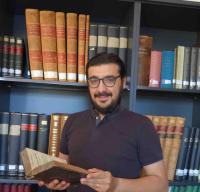As it is well known, the Coptic Old Testament is a daughter translation of the Greek Septuagint.[1] Unlike the Sahidic Old Testament, which was completely translated (unfortunately it did not survive in its entirety), the Old Testament was only partially translated into Bohairic (only the Pentateuch, Job, Psalms, and the Prophets are complete). Other books are only attested as excerpts, mostly in liturgical books as pericopae.[2]
The Sahidic influence was already observed by Burmester in some excerpts of Bohairic Old Testament books,[3] which are not widely copied, or of minor liturgical importance, as for example the Wisdom of Solomon, or Ecclesiasticus (Sirach), which are attested only as pericopae in the Holy Week Lectionary.[4]
Working on Bohairic manuscripts of the Holy Week Lectionary in the framework of the DFG project Project AT 193/2–1 “Digitale Edition und wissenschaftliche Erschließung des koptischen Paschalektionars,” I came across many Old Testament pericopae – in addition to the ones from Wisdom of Solomon and Ecclesiasticus – in which a Sahidic source is undeniably present. The following tables show a comparison between some words and sentences from these pericopae from the Sahidic Holy Week Lectionary sa 16L (before 1443 AD) and their parallels from the Bohairic Holy Week Lectionaries using two manuscripts which show Sahidic influences:
- bo 3005L = Vat. copt. 98 dated 1385 AD;
- bo 3014L = ICP Copte-Arabe (part I) 6 & bo 3015L = ICP Copte-Arabe 7 (part II) dated 1777 AD.[5]
In addition to the forms found in the manuscripts, the expected standard Bohairic forms are given. For the Bohairic forms in the Minor Prophets, I consulted Henry Tattam’s 1836 edition, but did not always follow it.
- Phonological and orthographical peculiarities:
1.1. Aspiration
Aspiration is one of the main phonological phenomena that distinguish Bohairic from other Coptic dialects. Voiceless plosives (ⲡ, ⲕ, ⲧ, ϫ) become aspirated (ⲫ, ⲭ, ⲑ, ϭ) before sonorants and stressed syllables. The following table shows some examples, in which the scribe or the translator rendered the Sahidic words into Bohairic without considering the aspiration:
| Table 1.1.1. | sa 16L,
fol. 19r–19v | bo 3005L,
fol. 115r–116r | bo 3014L,
fol. 81r–81v | Standard Bohairic form |
| 1Kgs 19:9 | ⲁϥⲡⲱϩ
| ⲁϥⲡⲓⲙϩⲧ (sic!)[6]
| ⲁϥⲡ̀ⲱϩⲧ
| ⲁϥⲫⲟϩ [7]
|
| ⲛⲧⲟⲕ
| ⲛ̇ⲧⲱⲕ
| ⲛ̀ⲧⲟⲕ
| ⲛ̀ⲑⲟⲕ
|
| 1Kgs 19:10 | ⲟⲩⲕⲱϩ ⲁⲓ̈ⲕⲱϩ
| ⲟⲩⲕⲟϩ ⲁⲓⲕⲟϩ
| ⲟⲩⲕⲱϩ ⲁⲓⲕⲱϩ
| ⲟⲩⲭⲟϩ ⲁⲓⲭⲟϩ
|
| ⲁⲩⲕⲁⲁⲕ
| ⲁⲩⲕⲁⲕ
| ⲁⲩⲕⲁⲕ
| ⲁⲩⲭⲁⲕ
|
| 1Kgs 19:12 | ⲧⲏⲩ
| ⲧⲏⲩ
| ⲧⲏⲟⲩ
| ⲑⲏⲟⲩ
|
1.2. Hypercorrection
The following examples show unnecessary correction of some words: aspiration of ⲧ before the sonorant ⲣ in ⲡⲉⲧⲣⲁ and replacing ϩ with ϧ (very common).
| Table 1.2.1. | sa 16L,
fol. 19r–19v | bo 3005L,
fol. 115v | bo 3014L,
fol. 81v | Standard Bohairic form |
| 1Kgs 19:11 | ⲡⲉⲧⲣⲁ
| ⲡⲉⲑⲣⲁ
| ⲡⲉⲑⲣⲁ
| ⲡⲉⲧⲣⲁ
|
| Table 1.2.2. | sa 16L,
fol. 135r | bo 3005L,
fol. 336v | bo 3015L,
fol. 256r | Standard Bohairic form |
| Mic 2:1 | ⲉ̇ϩ︤ⲛ︥ϩⲓ̈ⲥⲉ
| ⲉϧⲟⲩⲛϩⲓⲥⲓ (sic!)
| ⲉ̀ϧⲉⲛϩⲓⲥⲓ
| ⲉ̀ϩⲁⲛϧⲓⲥⲓ
|
| ϩ︤ⲛ︥ⲡⲉⲑⲟⲟⲩ
| ϧⲉⲛⲡⲉⲧϩⲱⲟⲩ
| ϧⲉⲛⲡⲉⲧϩⲱⲟⲩ
| ϩⲁⲛⲡⲉⲧϩⲱⲟⲩ
|
1.3. Other Sahidic influences on the orthography
In the following examples, the scribe did not write the words in their standard Bohairic form:
| Table 1.3.1. | sa 16L,
fol. 19r–19v | bo 3005L,
fol. 115r–116r | bo 3014L,
fol. 81r–81v | Standard Bohairic form |
| 1Kgs 19:9 | ⲉⲕⲣⲟⲩ
| ⲉⲕⲣⲟⲩ
| ⲉⲕⲣⲟ
| ⲉⲕⲉⲣⲟⲩ
|
| 1Kgs 19:11 | ⲉϥⲧⲁϫⲣⲏⲩ
| ⲉϥⲧⲁϫⲣⲏⲟⲩ
| ⲉϥⲧⲁϫⲣⲏⲟⲩ
| ⲉϥⲧⲁϫⲣⲏⲟⲩⲧ
|
| 1Kgs 19:13 | ⲁϩⲣⲟⲕ
| ⲁϩⲣⲟⲕ
| ⲁ̀ϩⲁⲣⲟⲕ
| ⲁϧⲣⲟⲕ
|
| Table 1.3.2. | sa 16L,
fol. 135r | bo 3005L,
fol. 336r | bo 3015L,
fol. 255v | Standard Bohairic form |
| Mic 1:15 | ϩⲉⲉⲕⲉϫⲱ
| ϩⲉⲕϫⲱ[8]
| ϩⲉⲕⲉϫⲱ
| ϧⲉⲕϫⲱ
|
- Morphological and syntactical misinterpretation and misunderstanding:
Another indication of Sahidic influence is misanalysing Sahidic phrases. The Bohairic scribe or translator either copied them as they are or misinterpreted them resulting in ungrammatical phrases.
For example, the Sahidic definite article for plural ⲛ- is analyzed as the particle ⲛ- (1Kgs 19:10, Table 2.1.) and the genitive particle with the definite article for plural ⲛ- is analyzed as the possessive prefix (ⲛ︤ⲛ︥ϭⲟⲙ > ⲛⲉⲛϫⲟⲙ) (1Kgs 19:10, Table 2.1.). We can also find forms copied from Sahidic, for example, the Sahidic ⲛⲉⲣⲉ- instead of the Bohairic ⲛⲁⲣⲉ- (1Kgs 19:11, Table 2.1.), Greek Verbs without the auxiliary ⲉⲣ- (Mic 2:2 Table 2.2.), the use of the Sahidic Temporal ⲛ̄ⲧⲉⲣⲉ- instead of its Bohairic counterpart ⲉⲧⲁ- (1Kgs 19:13, Table 2.1.) and the Sahidic forms of some words, for instance, ⲛ̄ⲛ̄ⲧⲟⲩⲉⲓ̈ⲏ̇ (1Kgs 19:11, Table 2.1.) and ⲛⲁⲩ “to them” (Hos 7:13, Table 2.3.).
The most interesting, and maybe the most common phenomenon, is misinterpreting almost every consonant cluster ⲙⲛ as the conjunction/preposition ⲛⲉⲙ, for instance, ⲙ︤ⲛ︥ⲛ̄ⲥⲁ > ⲛⲉⲙ ⲛ̇ⲥⲁ (1Kgs 19:12, Table 2.1.); ⲙ︤ⲛ︥ⲧⲭⲏⲣⲁ > ⲛⲉⲙ ⲧ̀ⲭⲏⲣⲁ (Mic 1:16, Table 2.2.).
| Table 2.1. | sa 16L,
fol. 19r–19v | bo 3005L,
fol. 115r–116r | bo 3014L,
fol. 81r–81v | Standard Bohairic form |
| 1Kgs 19:10 | ⲡ̄ⲛⲟⲩⲧⲉ ⲛ︤ⲛ︥ϭⲟⲙ
| ⲫϯ ⲛⲉⲛϫⲟⲙ̇
| ⲫϯ ⲛⲉⲛϫⲟⲙ
| ⲫϯ ⲛ̀ⲧⲉ ⲛⲓϫⲟⲙ
|
| ⲉⲃⲟⲗ ϫⲉ ⲛ̄ϣⲏⲣⲉ
| ⲉⲃⲟⲗ ϫⲉ ⲛ̇ϣⲏⲣⲓ
| ⲉⲃⲟⲗ ϫⲉ ⲛ̀ϣⲏⲣⲓ
| ⲉⲃⲟⲗ ϫⲉ ⲛⲓϣⲏⲣⲓ
|
| 1Kgs 19:11 | ⲛ︤ⲅ︥ⲁ̇ϩⲉ ⲣⲁⲧ︤ⲕ︥
| ⲛⲉⲅⲁϩⲉⲣⲁⲧⲕ
| ⲛⲉⲅⲁϩⲉ̀ⲣⲁⲧⲕ
| ⲛ̀ⲧⲉⲕⲟ̀ϩⲓ ⲉ̀ⲣⲁⲧⲕ
|
| ⲛ̄ⲛ̄ⲧⲟⲩⲉⲓ̈ⲏ̇
| ⲛⲉⲛⲧⲟⲩⲉ̇ⲓⲏ̇
| ⲛⲉⲛⲧⲟⲩⲉ̀ⲓ̀ⲏ̀
| ⲛ̀ⲛⲓⲧⲱⲟⲩ
|
| ⲛⲉⲣⲉⲡϫⲟⲉⲓ̈ⲥ
| ⲛⲉⲣⲉⲡ⳪︦
| ⲛⲉⲣⲉⲡ⳪︦
| ⲛⲁⲣⲉⲡ⳪︦
|
| 1Kgs 19:12 | ⲙ︤ⲛ︥ⲛ̄ⲥⲁ
| ⲛⲉⲙ ⲛ̇ⲥⲁ
| ⲛⲉⲙ ⲛ̀ⲥⲁ
| ⲙⲉⲛⲉⲛⲥⲁ
|
| 1Kgs 19:13 | ⲛ̄ⲧⲉⲣⲉϩⲏⲗⲓ̈ⲁⲥ
| ⲛ̇ⲧⲉⲣⲉⲏ̇ⲗⲓⲁⲥ
| ⲛ̀ⲧⲉⲣⲉⲏ̀ⲗⲓⲁⲥ
| ⲉⲧⲁⲏⲗⲓⲁⲥ
|
| Table 2.2. | sa 16L,
fol. 135r | bo 3005L,
fol. 336r–336v | bo 3015L,
fol. 255v–256r | Standard Bohairic form |
| Mic 1:16 | ⲧⲁϣⲟ
ⲛ̄ⲧⲟⲩⲙ︤ⲛ︥ⲧⲭⲏⲣⲁ
| ⲧⲁϣⲟ ⲛ̀ⲧⲟⲩ ⲛⲉⲙ
ⲉⲧⲭⲏⲣⲁ (sic!)
| ⲧⲁϣⲟ ⲛ̀ⲧⲟⲩ ⲛⲉⲙ
ⲧ̀ⲭⲏⲣⲁ (sic!)
| ⲟⲩⲱϣⲥ ⲉ̀ⲃⲟⲗ ⲛ̀ⲧⲉⲙⲉⲧⲭⲏⲣⲁ
|
| Mic 2:2 | ⲁⲩⲉ̇ⲡⲉⲑⲩⲙⲉⲓ̈
| ⲁⲩⲉ̀ⲡⲓⲑⲩⲙⲓ
| ⲁⲩⲉ̀ⲡⲓⲑⲩⲙⲓ
| ⲁⲩⲉⲣⲉ̀ⲡⲓⲑⲩⲙⲓⲛ
|
| Table 2.3. | sa 16L,
fol. 160v–161r | bo 3005L,
fol. 371v–372r | bo 3015L,
fol. 283v | Standard Bohairic form |
| Hos 7:13 | ⲛⲁⲩ
| ⲛⲁⲩ
| ⲛⲁ
| ⲛⲱⲟⲩ
|
| ⲟⲩⲛⲟⲩⲙ︤ⲛ︦ⲧ︥ⲉⲃⲓ̈ⲏⲛ
| ⲟⲩⲛⲟⲩ ⲛⲉⲙ ⲧⲉⲃⲓⲏⲛ
| ⲟⲩⲛⲟⲩ ⲛⲉⲙ ⲧⲏⲃⲛⲏⲓ
| ϩⲁⲛⲉ̀ⲃⲓⲏⲛ[9]
|
| ⲟⲩⲙ︤ⲛ︥ⲧⲛⲟⲩϫ
| ϩⲁⲛⲛⲉⲙⲉⲧⲛⲟⲩϫ
| ϩⲁⲛⲛⲉⲙⲉⲧⲛⲟϫ
| ϩⲁⲛⲙⲉⲑⲛⲟⲩϫ
|
| Hos 7:16 | ⲙ̄ⲙ︤ⲛ︥ⲧⲁⲧⲥ̄ⲃⲱ
| ⲙ̀ⲙⲉⲛⲧⲁϯⲥⲃⲱ
| ⲙ̀ⲙⲉⲛⲧⲁϯⲥⲃⲱ
| ϯⲙⲉⲧⲁⲧⲥⲃⲱ
|
| Table 2.4. | sa 16L, fol. 171v | bo 3005L, fol. 387r | bo 3015L, fol. 296r | Standard Bohairic form |
| Josh 5:10 | ϩ︤ⲛ︥ ⲥⲟⲩⲙⲛⲧⲁϥⲧⲉ ⲙ̄ⲡⲉⲃⲟⲧ | ϧⲉⲛ ⲥⲟⲩⲛⲉⲙⲓ︤ⲇ︥ϯ ⲙ̀ⲡⲓⲁ̀ⲃⲟⲧ
| ϧⲉⲛ ⲥⲟⲩⲛⲉⲙⲓ︤ⲇ︥ ⲙ̀ⲡⲓⲁ̀ⲃⲟⲧ
| ϧⲉⲛ ⲥⲟⲩⲓ︤ⲇ︥ ⲙ̀ⲡⲓⲁ̀ⲃⲟⲧ
|
- Lexical influences:
The Sahidic Vorlage influenced the Bohairic translation, not only on the morphophonological or syntactic level, but also on the lexical one.
3.1. Using Sahidic lexemes in the Bohairic translation that are usually not common in Bohairic:
| Table 3.1.1. | sa 16L,
fol. 19r–19v | bo 3005L,
fol. 115v–116r | bo 3014L,
fol. 81r–81v | Standard Bohairic form |
| 1Kgs 19:10 | ⲁⲩⲙⲟⲟⲩⲧⲟⲩ
| ⲁⲩⲙⲟⲟⲩⲧⲟⲩ
| ⲁⲩⲙⲟⲟⲩⲧⲟⲩ
| ⲁⲩϧⲟⲑⲃⲟⲩ
|
| 1Kgs 19:12 | ⲡⲕⲱϩⲧ
| ⲡⲓⲕⲱϩⲧ
| ⲡⲓⲕⲱϩⲧ
| ⲡⲓⲭⲣⲱⲙ
|
| Table 3.1.2. | sa 16L,
fol. 135r–135v | bo 3005L,
fol. 336r–337r | bo 3015L,
fol. 256r–256v | Standard Bohairic form |
| Mic 1:16 | ⲛ̄ⲑⲉ
| ⲛ̀ⲑⲉ
| ⲛ̀ⲑⲉ
| ⲙ̀ⲫⲣⲏϯ
|
| Amos 2:7 | ⲁⲩⲃⲱⲕ
| ⲟⲩⲃⲱⲕ[10]
| ⲁⲩⲃⲱⲕ
| ⲛⲁⲩⲛⲁ
|
3.2. In some cases, the Bohairic text shows Greek words, where standard Bohairic texts (as the Bohairic NT) would use a word of Egyptian origin:
| Table 3.2.1. | sa 16L,
fol. 19r | bo 3005L,
fol. 115v | bo 3014L,
fol. 81r–81v | Standard Bohairic form |
| 1Kgs 19:10 | ⲛⲉⲕⲑⲩⲥⲓ̈ⲁⲥⲧⲏⲣⲓ̈ⲟⲛ
| ⲛⲉⲕⲑⲩⲥⲓⲁ̀ⲥⲧⲏⲣⲓⲟⲛ
| ⲛⲉⲕⲑⲩⲥⲓⲁ̀ⲥ̀ⲧⲏⲣⲓⲟⲛ
| ⲛⲉⲕⲙⲁ ⲛⲉⲣϣⲱⲟⲩϣⲓ[11]
|
| 1Kgs 19:11 | ⲛⲁⲡⲁⲣⲁⲅⲉ
| ⲛⲁⲡⲁⲣⲁⲅⲉ
| ⲛⲁⲡⲁⲣⲁⲅⲉ
| ⲛⲁⲥⲓⲛⲓ
|
| Table 3.2.2. | sa 16L,
fol. 135r | bo 3005L,
fol. 336v | bo 3015L,
fol. 256r | Standard Bohairic form |
| Mic 1:16 | ⲁⲓ̈ⲧⲟⲥ
| ⲁⲓⲧⲟⲥ
| ⲁⲓⲧⲟⲥ
| ⲁ̀ϧⲱⲙ[12]
|
These pericopae and many others that show influences from Sahidic are not attested in other Bohairic Holy Week Lectionaries.[13] The two parts of the Bohairic Holy Week Lectionary bo 3014L & bo 3015L were used in the White Monastery[14] in Upper Egypt where the Sahidic Holy Week Lectionaries were most probably kept.
The following observations can be made from the previous examples:
- The scribe (and/or the translator) did indeed have some basic background knowledge about the differences between Sahidic and Bohairic; for instance, S
ⲙⲛ > B ⲛⲉⲙ, some Sahidic words with ϩ have ϧ in Bohairic, the atonic ⲉ at the end of a word in Sahidic is written ⲓ in Bohairic, and aspiration (cf. Table 1.1.1.). - Nevertheless, the scribe (and/or the translator) was unable to understand some parts of the Sahidic texts. This is evident from his copying Sahidic words with/without a slight modification (according to the Bohairic orthographical and phonological rules) and incorrectly analyzing the texts (cf. Table 2.1.–2.4.).
- For these passages with Sahidic influences, the scribe seems most probably to have translated them directly from a Sahidic Vorlage and not to have used a copy of the Bohairic Bible, even if a Bohairic translation of the biblical book existed. Evidence for this is the pericope of Amos 3:1–10, which is read twice during the Holy Week according to bo 3005L and the second part of the 18th-century lectionary bo 3015L (once on Good Friday morning and once at the sixth hour of Maundy Thursday evening), and once according to the other witnesses (only at the sixth hour of Maundy Thursday evening). The one read on Maundy Thursday and witnessed in all manuscripts identified in the DFG project AT 193/2–1 shows no Sahidic influence, unlike the one read on Good Friday. What is the reason for such differences in the two versions of Amos 3:1–10? When did this difference emerge? Maybe the Amos pericope with the Sahidic influences emerged later and the scribe did not have access to a copy of the Bohairic Bible? We cannot be sure.
These observations raise questions concerning the linguistic situation at least in the White Monastery in the second millennium. It appears that Sahidic and Bohairic were not completely and mutually intelligible, and the knowledge of Coptic was in full decline. Even if Coptic was no longer understood, we can assume that these biblical passages were read aloud in Coptic; a habit that is still practiced today in the liturgy of the Coptic Church.
Bibliography
Böhlig, Alexander. 1954a. Die griechischen Lehnwörter im sahidischen und im bohairischen Neuen Testament, Studien zur Erforschung des christlichen Aegyptens, Heft 2, München.
________. 1954b. Register und Vergleichstabellen zu Heft 2, Studien zur Erforschung des christlichen Aegyptens, Heft 2A, München.
Burmester, Oswald Hugh Edward. 1934. “The Bohairic Pericopae of Wisdom and Sirach,” in: Biblica 15, 451–465.
________. 1935. “The Bohairic Pericopae of Wisdom and Sirach,” in: Biblica 16, 25–57, 141–174.
Feder, Frank. 2008. “The Coptic Version(s) of the Book of Jesus Sirach,” in: Géza G. Xeravits and József Zsengellér (eds.), Studies in the Book of Ben Sira, Papers of the Third International Conference on the Deuterocanonical Books, Shime'on Centre, Pápa, Hungary, 18–20 May, 2006, Leiden and Boston, 11–20.
________. 2020. “1.1.6 The Coptic Canon,” in: Frank Feder and Matthias Henze (eds.), Textual History of the Bible. The Deuterocanonical Scriptures, Vol. 2A: 1 Overview Articles, 1.1 The Canonicle Histories of the Deuterocanonical Texts, Leiden and Boston, 213a–239.
Lagarde, Paul de. 1879. Orientalia. Teil I: Die koptischen Handschriften der Göttinger Bibliothek. Bruchstücke der koptischen Übersetzung des Alten Testaments, Abhandlungen der Königlichen Gesellschaft der Wissenschaften zu Göttingen, Philologisch-historische Klasse 24, Göttingen.
Lefort, Louis Théophile. 1925. S. Pachomii vita: Bohairice scripta, CSCO 89, Scriptores Coptici 7, Paris.
Tattam, Henry. 1836. ⲛⲓϫⲱⲙ ⲛⲧⲉ ⲛⲓⲓ︤ⲃ︥ ⲛⲛⲓⲡⲣⲟⲫⲏⲧⲏⲥ ⲛⲕⲟⲩϫⲓ ϧⲉⲛ ϯⲁⲥⲡⲓ ⲛⲧⲉ ⲛⲓⲣⲉⲙⲛⲭⲏⲙⲓ Duodecim prophetarum minorum libros in lingua Aegyptiaca vulgo Coptica seu Memphitica, Oxford.
[2] Feder 2020, 235–238. See, for example, the excerpts (mostly from the Historical Books) which Paul de Lagarde collected from liturgical manuscripts (Lagarde 1879, 64).
[3] Cf. Burmester 1934, 454.
[4] Cf. Burmester 1934; Feder 2008, 16.
[5] bo 3014L and bo 3015L are actually two parts of the same codex, but each has its own binding. The former begins with Palm Sunday and ends with Maundy Thursday evening, and the later begins with Maundy Thursday morning and ends with Easter Monday.
[6] It is not uncommon for scribes to confuse the three arms of the ⲱ with ⲓ and ⲙ.
[7] Besides being influenced by the Sahidic Vorlage, for unknown reasons the Bohairic scribe used the verb ⲡⲱϩⲧ/ⲫⲱϧⲧ in this example instead of ⲡⲱϩ/ⲫⲟϩ.
[8] It was originally written ϩⲉⲕⲉϫⲱ, but the second ⲉ was then erased.
[9] The literal equivalent of the Sahidic would be ⲟⲩⲟⲛⲟⲩⲙⲉⲧⲉⲃⲓⲏⲛ.
[10] The scribe apparently interpreted it as the noun ⲃⲱⲕ “servant”.
[11] The Greek word θυσιαστήριον “altar” is not found in the Bohairic NT but appears, e.g., four times in the Life of St. Pachomius (see Böhlig 1954b, 48–49; Lefort 1925, 238). The word ⲙⲁ ⲛⲉⲣϣⲱⲟⲩϣⲓ is used instead (Böhlig 1954a, 313).
[12] The Greek word ἀετός “eagle” is not found in the Bohairic NT but is found once in a hymn for St. Pachomius (see Böhlig 1954b, 6–7; Lefort 1925, 231). The word ⲁϧⲱⲙ is used instead (Böhlig 1954a, 161).
[13] At least among the known Bohairic Holy Week Lectionaries identified in the DFG project.
[14] As read in the Arabic colophon (bo 3015L, fol. 399v): “An eternal dedication […] to the church of the greatest among the saints, the great saint, our father, Apa Shenoute […] which is also called ‘the White Monastery’”.
 Blogs
Blogs  Recent Bloggers
Recent Bloggers 




